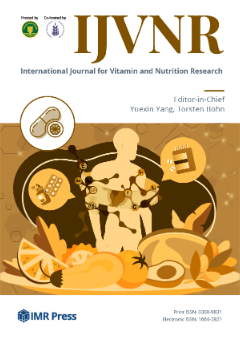International Journal for Vitamin and Nutrition Research (IJVNR) is published by IMR Press from Volume 95 Issue 1 (2025). Previous articles were published by another publisher under a hybrid publishing model, and they are hosted by IMR Press on imrpress.com as a courtesy and upon agreement with Hogrefe.
Measurement of Zinc Absorption From Meals: Comparison of Extrinsic Zinc Labeling and Independent Measurements of Dietary Zinc Absorption
Background: Extrinsic labeling techniques are typically used to measure fractional absorption of zinc (FAZextrinsic) but none have been adequately evaluated. Objective: To compare determination of the quantity of zinc absorbed (TAZextrinisic) using measurements of FAZextrinsic with results of simultaneous determinations of dietary zinc absorbed (TAZmetabolic) that are not dependent on labeling ingested food with an extrinsic tracer (modified metabolic balance technique). Design: 70Zn was administered orally with all meals for 6 consecutive days to 21 healthy, free-living adult women consuming a constant diet. 68Zn and 67Zn were administered intravenously. FAZextrinsic was measured using a dual isotope tracer ratio technique and multiplied by dietary zinc to give TAZextrinsic. TAZmetabolic was determined by addition of net absorption of zinc and endogenous fecal zinc, the latter determined by an isotope dilution technique. Results: TAZextrinsic and TAZnetabolic were 3.0 ± 1.1 mg/day and 3.1 ± 1.1 mg/day respectively, paired t-test p = 0.492. The correlation coefficient for TAZextrinsic and TAZmetabolic was 0.91, and for FAZextrinsic and FAZmetabolic was 0.95. A Bland Altman analysis indicated a bias of 0.07, and the limits of agreement of -0.86 to 1.01 for TAZextrinsic and TAZmetabolic. Conclusion: These results from two independent methods provide reasonable validation of our extrinsic labeling technique for a wide range of composite diets.

